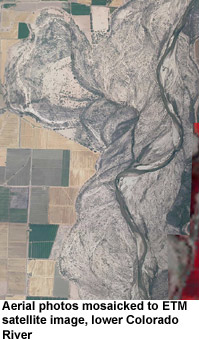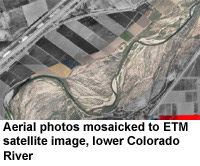
community | data | history | publication list | partners
El Niño
Habitats
Legal Issues
People
More on legal issues
References
Full Report
|
Colorado River Delta Institutions cont.
After a long dispute between Mexico and the U.S. about the quality of water delivered to Mexico, which had been degraded by brackish discharge from Arizona's Wellton-Mohawk Irrigation and Drainage District in the early 1960s, the two countries adopted Minute 242 of the International Boundary and Water Commission (Wahl 1989). Minute 242 states that 1,360 KAF (1,678 MCM) of annual water deliveries to Mexico at Morelos Dam would have an average salinity no more than 115 ppm (±30 ppm) greater than the salinity of the river at Imperial Dam; the remaining 140 KAF (173 MCM), delivered at the International Boundary with Mexico near San Luis, would have "a salinity substantially the same as that of the waters customarily delivered there" (in Hundley 1986:39). Congress then passed the Colorado River Basin Salinity Control Act of 1974, authorizing measures to enable compliance with Minute 242, including the construction of the $250 million Yuma Desalting Plant (Wahl 1989) and the construction of the Main Outlet Drain Extension (MODE) and its bypass extension, discharging agricultural drainage into Mexico's Cienega de Santa Clara (Glenn et al. 1992). The Mexican Constitution establishes the legal
framework for water management in Mexico and reserves to the federal
government
the rights to national waters, |
 Within the Law of the River are two main elements
addressing U.S. obligations to Mexico: the 1944 Treaty on the Utilization
of Waters of the Colorado and Tijuana Rivers and of the Rio Grande
with Mexico and Minute 242 of the International Boundary
and Water Commission (IBWC), issued in 1973. The former guarantees
delivery of 1,500 KAF (1,850 MCM)/year to Mexico. In the absence
of surplus flows, the responsibility for the delivery of these waters
is to be shared equally by the upper and lower basins (Hundley 1966;
1975). Article 10(b) of the Treaty allocates an additional 200 KAF
(246.7 KAF) to Mexico when the U.S. Section of IBWC determines that
there exists a surplus of Colorado River water above the amount
needed to supply U.S. uses; such Treaty surpluses were declared
1997-2000. In 1996, a limited U.S. surplus was declared to satisfy
the diversion orders of users upstream of the study area; no surplus
waters were made available that year for Mexico.
Within the Law of the River are two main elements
addressing U.S. obligations to Mexico: the 1944 Treaty on the Utilization
of Waters of the Colorado and Tijuana Rivers and of the Rio Grande
with Mexico and Minute 242 of the International Boundary
and Water Commission (IBWC), issued in 1973. The former guarantees
delivery of 1,500 KAF (1,850 MCM)/year to Mexico. In the absence
of surplus flows, the responsibility for the delivery of these waters
is to be shared equally by the upper and lower basins (Hundley 1966;
1975). Article 10(b) of the Treaty allocates an additional 200 KAF
(246.7 KAF) to Mexico when the U.S. Section of IBWC determines that
there exists a surplus of Colorado River water above the amount
needed to supply U.S. uses; such Treaty surpluses were declared
1997-2000. In 1996, a limited U.S. surplus was declared to satisfy
the diversion orders of users upstream of the study area; no surplus
waters were made available that year for Mexico. including the Colorado River (Castro
1995). The Constitution also reserves ownership of groundwater to
the national government (Cossio 1995). In practice, Mexico's Comision
Nacional de Aguas (CNA) determines deliveries of Colorado River
water and regulates groundwater extraction within the delta region
(Mumme 1996). CNA determined cropping patterns and allocated water
accordingly. In recent years, however, efforts have begun to decentralize
this authority and provide for greater autonomy at the local level
(Clinton et al. 2001).
including the Colorado River (Castro
1995). The Constitution also reserves ownership of groundwater to
the national government (Cossio 1995). In practice, Mexico's Comision
Nacional de Aguas (CNA) determines deliveries of Colorado River
water and regulates groundwater extraction within the delta region
(Mumme 1996). CNA determined cropping patterns and allocated water
accordingly. In recent years, however, efforts have begun to decentralize
this authority and provide for greater autonomy at the local level
(Clinton et al. 2001).